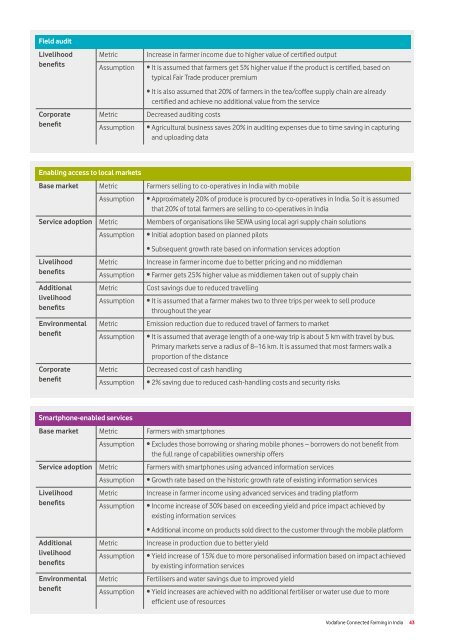Connected-Farmers
Connected-Farmers
Connected-Farmers
Create successful ePaper yourself
Turn your PDF publications into a flip-book with our unique Google optimized e-Paper software.
Field audit<br />
Livelihood<br />
benefits<br />
Corporate<br />
benefit<br />
Metric<br />
Assumption<br />
Metric<br />
Assumption<br />
Increase in farmer income due to higher value of certified output<br />
• It is assumed that farmers get 5% higher value if the product is certified, based on<br />
typical Fair Trade producer premium<br />
• It is also assumed that 20% of farmers in the tea/coffee supply chain are already<br />
certified and achieve no additional value from the service<br />
Decreased auditing costs<br />
• Agricultural business saves 20% in auditing expenses due to time saving in capturing<br />
and uploading data<br />
Enabling access to local markets<br />
Base market Metric <strong>Farmers</strong> selling to co-operatives in India with mobile<br />
Assumption • Approximately 20% of produce is procured by co-operatives in India. So it is assumed<br />
that 20% of total farmers are selling to co-operatives in India<br />
Service adoption Metric Members of organisations like SEWA using local agri supply chain solutions<br />
Livelihood<br />
benefits<br />
Additional<br />
livelihood<br />
benefits<br />
Environmental<br />
benefit<br />
Corporate<br />
benefit<br />
Assumption<br />
Metric<br />
Assumption<br />
Metric<br />
Assumption<br />
Metric<br />
Assumption<br />
Metric<br />
Assumption<br />
• Initial adoption based on planned pilots<br />
• Subsequent growth rate based on information services adoption<br />
Increase in farmer income due to better pricing and no middleman<br />
• Farmer gets 25% higher value as middlemen taken out of supply chain<br />
Cost savings due to reduced travelling<br />
• It is assumed that a farmer makes two to three trips per week to sell produce<br />
throughout the year<br />
Emission reduction due to reduced travel of farmers to market<br />
• It is assumed that average length of a one-way trip is about 5 km with travel by bus.<br />
Primary markets serve a radius of 8–16 km. It is assumed that most farmers walk a<br />
proportion of the distance<br />
Decreased cost of cash handling<br />
• 2% saving due to reduced cash-handling costs and security risks<br />
Smartphone-enabled services<br />
Base market Metric <strong>Farmers</strong> with smartphones<br />
Assumption • Excludes those borrowing or sharing mobile phones – borrowers do not benefit from<br />
the full range of capabilities ownership offers<br />
Service adoption Metric <strong>Farmers</strong> with smartphones using advanced information services<br />
Assumption • Growth rate based on the historic growth rate of existing information services<br />
Livelihood Metric Increase in farmer income using advanced services and trading platform<br />
benefits<br />
Assumption • Income increase of 30% based on exceeding yield and price impact achieved by<br />
existing information services<br />
Additional<br />
livelihood<br />
benefits<br />
Environmental<br />
benefit<br />
Metric<br />
Assumption<br />
Metric<br />
Assumption<br />
• Additional income on products sold direct to the customer through the mobile platform<br />
Increase in production due to better yield<br />
• Yield increase of 15% due to more personalised information based on impact achieved<br />
by existing information services<br />
Fertilisers and water savings due to improved yield<br />
• Yield increases are achieved with no additional fertiliser or water use due to more<br />
efficient use of resources<br />
Vodafone <strong>Connected</strong> Farming in India 43


